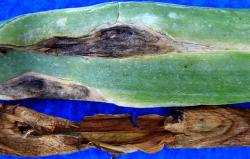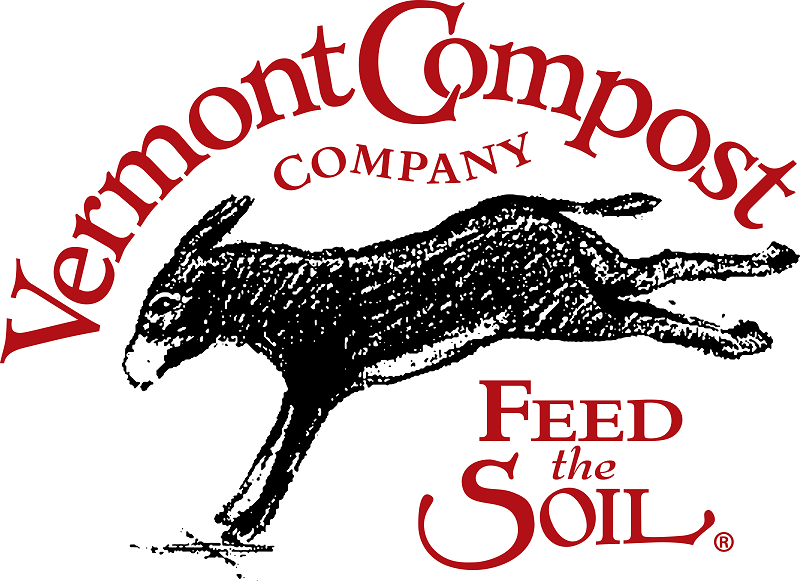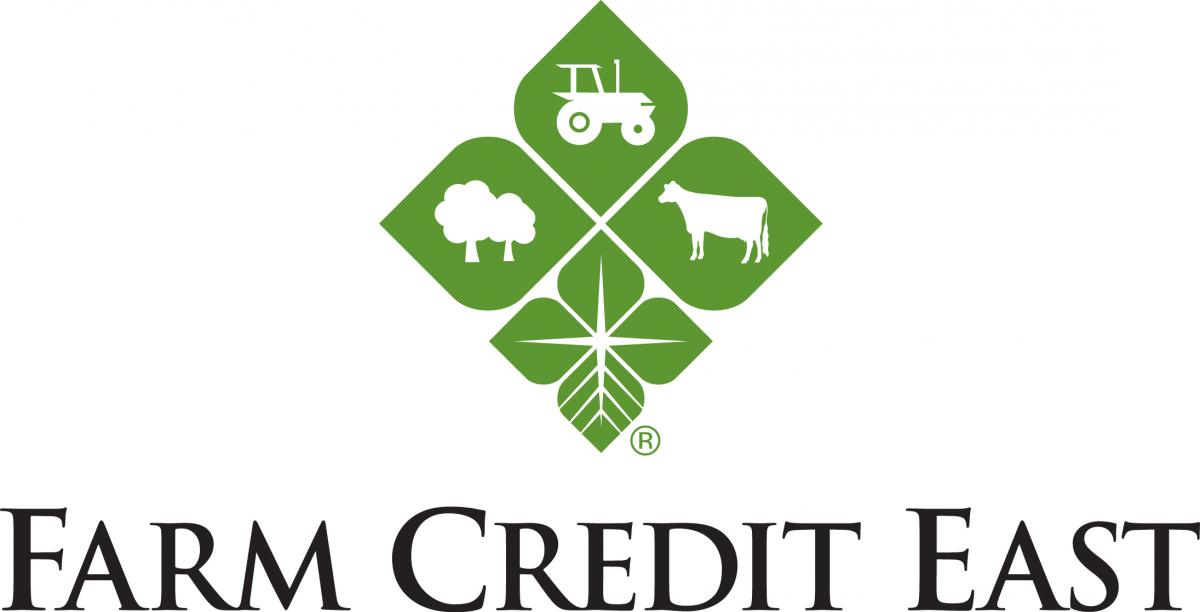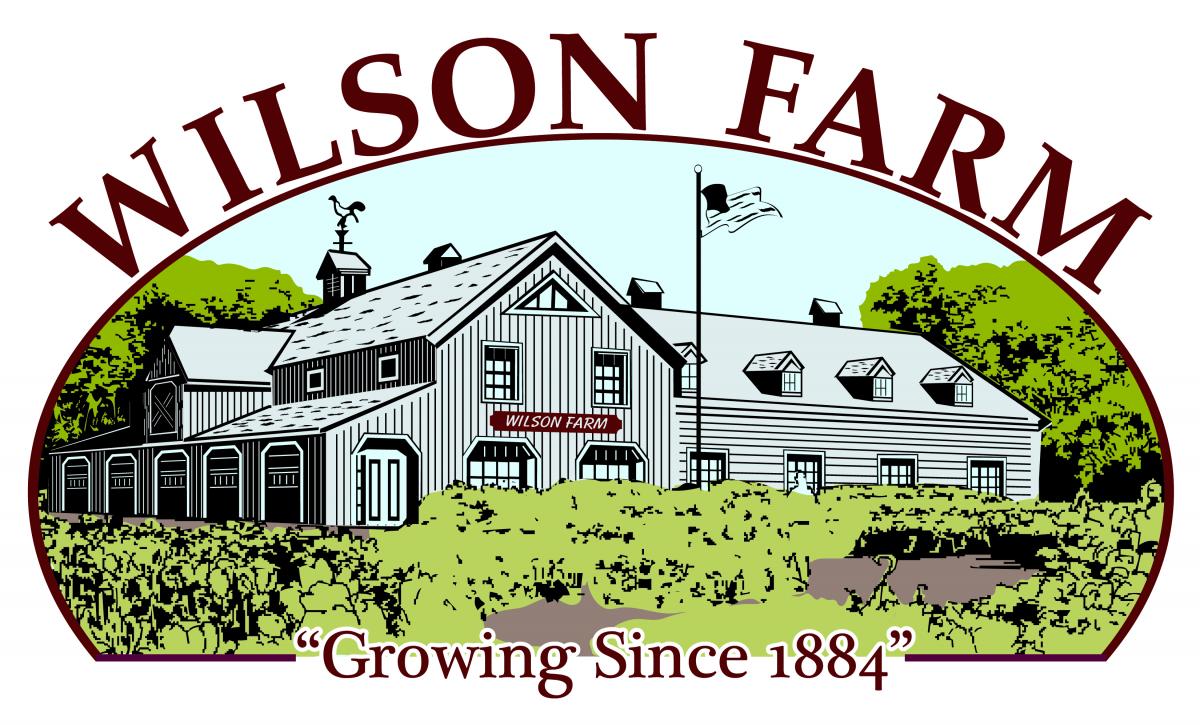To print this issue, either press CTRL/CMD + P or right click on the page and choose Print from the pop-up menu.

Crop Conditions
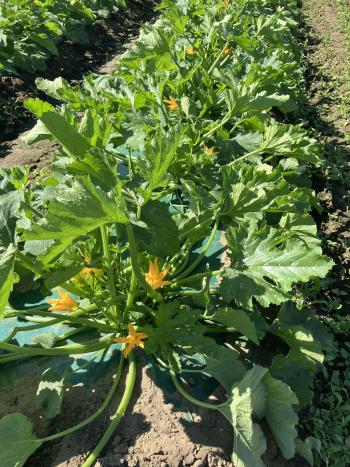 It rained this week, in some places quite heavily in a short period of time, making fields inaccessible. Crops that are already planted are starting to look lush—kale, collards, and cabbage plantings are filling in, potatoes are up and folks are hilling, and strawberries are ripening, with the first berries on shelves now! Sweet potatoes have been planted, and brassicas and greens continue to go in. Field tomatoes are taking off, so now trellising is a regular task, along with continual planting, harvesting, and weeding. We’re still in the early season of greens, greens, greens on farmstand shelves and wholesale lists, but summer squash is around the corner.
It rained this week, in some places quite heavily in a short period of time, making fields inaccessible. Crops that are already planted are starting to look lush—kale, collards, and cabbage plantings are filling in, potatoes are up and folks are hilling, and strawberries are ripening, with the first berries on shelves now! Sweet potatoes have been planted, and brassicas and greens continue to go in. Field tomatoes are taking off, so now trellising is a regular task, along with continual planting, harvesting, and weeding. We’re still in the early season of greens, greens, greens on farmstand shelves and wholesale lists, but summer squash is around the corner.
We have a full schedule of summer field walks and twilight meetings, with the first coming up in a few weeks on June 12 at Tangerini's Farm in Millis. We'll be hearing from farm owner Steve Chiarizio about the new tile drainage system and bioreactor that they installed at the farm last year. A representative from Alleghany Services, who installed the system, will also be on-hand to answer questions. And Maria Gannett, UMass Extension Weed Specialist, and Sue Scheufele, UMass Extension Vegetable IPM Specialist, will talk about sweet corn weed and insect pest management options. Register in advance so we can get a headcount for food ordering! See the Events section for more info, or click here to register.
Pest Alerts
Alliums
Allium leafminer: We saw mining damage from ALM in early scallions this week in Berkshire Co. At this point, it is too late for effective chemical treatment. These larvae will mine to the base of the plants and pupate either between the bulb layers or in the soil. The next generation of adults will emerge in September and primarily pose a risk to leek crops. Take note of fields that are infested now with ALM and plan to cover susceptible crops in the fall or scout for oviposition marks and be ready to treat.
Onion thrips: We saw our first onion thrips in Berkshire Co. yesterday, and we expect these to start to take off in warmer areas with warm temperatures in the forecast. Thrips are tiny, elongate insects, about 2 mm long. They often hide between leaves at the base of allium plants during sunny days. They have rasping mouthparts that they use to feed on foliage, leaving behind feeding damage that looks like silvery speckles. Feeding damage also allows for entry of bacterial pathogens into leaves, which can lead to bacterial bulb rots later on. Now that thrips are out, scout crops weekly, gently pulling leaves apart from each other to check within the plant. An insecticide application is warranted if 1-3 thrips/leaf are found. Organic growers should use the lower 1 thrips/leaf threshold. The most effective material for organic growers is spinosad (e.g. Entrust). Apply with insecticidal soap (e.g. M-Pede, at the 1.5% v:v rate) to increase efficacy. Entrust can only be used two times in a row before rotating to a different insecticide class. Neem oil (e.g. Trilogy) and azadirachtin (e.g. Azatin O) may be effective also if applied when populations are still low. Pyrethrin (e.g. Pyganic) can provide knockdown control. Labeled conventional materials include neonicotinoids (e.g. Assail, Admire Pro), pyrethroids (e.g. Delta Gold, Declare, Warrior, Pounce, Mustang), spinetoram (e.g. Radiant), and spirotetramat (e.g. Movento). Movento and the neonicotinoids are systemic or translaminar and will work by ingestion; pyrethroids work on contact and will not have long residuals. Use an adjuvant with all materials to help them adhere to waxy allium leaves, unless it says otherwise on the label.
Brassicas
More of the same: flea beetles are continuing to feed on tender young plants and imported cabbageworm moths are continuing to lay eggs; earlier-laid eggs should be hatching soon.
Chenopods
Striped cucumber beetle adults are continuing to move into cucurbit fields. See the article in last week's issue for management recommendations.
Leafminers are continuing to tunnel in beets, spinach, and Swiss chard. Infested leaves can be removed and destroyed (feed to chickens, put in the trash, run over repeatedly with a truck—make sure the larvae are killed and not left to pupate in a cull pile!). Rotate successions of chenopod crops far from each other. Flies can be excluded from new plantings using row cover, as long as the field doesn’t have a recent history of infestation. Treatment with a systemic insecticide may prevent further damage. For labeled materials, see the beet and Swiss chard or spinach insect control section of the New England Vegetable Management Guide. For organic growers, spinosad (e.g. Entrust) is the most effective material—it needs to be applied when eggs are first seen so that hatching larvae will consume the material as they mine into the leaf.
Cucurbits
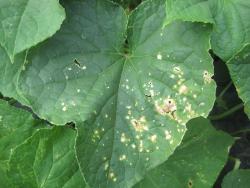 Angular leaf spot was diagnosed this week cucurbit seedlings in greenhouses on two different farms—on ‘Athena’ cantaloupe on one farm and on 'Moon and Stars', moving to 'Sugar Baby' on another farm. This disease can be seedborne. If infected seedlings are planted out into the field, the bacteria will spread from plant to plant by splashing rain or runoff, or insects or workers moving through the field. Symptoms begin as small, round, water-soaked spots, which expand until they are confined by veins, giving the characteristic angular look. The spots dry out and turn yellow-brown, and the dead tissue may fall out of the center, leaving a “shot-hole” appearance. If caught early in the field, copper may be effective in reducing the spread of angular leaf spot.
Angular leaf spot was diagnosed this week cucurbit seedlings in greenhouses on two different farms—on ‘Athena’ cantaloupe on one farm and on 'Moon and Stars', moving to 'Sugar Baby' on another farm. This disease can be seedborne. If infected seedlings are planted out into the field, the bacteria will spread from plant to plant by splashing rain or runoff, or insects or workers moving through the field. Symptoms begin as small, round, water-soaked spots, which expand until they are confined by veins, giving the characteristic angular look. The spots dry out and turn yellow-brown, and the dead tissue may fall out of the center, leaving a “shot-hole” appearance. If caught early in the field, copper may be effective in reducing the spread of angular leaf spot.
Nightshades
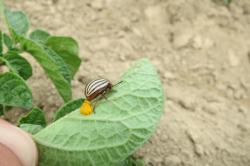 Colorado potato beetles are emerging now, moving slowly into potato and eggplant fields from overwintering sites in last year’s crops and in field edges. Crop rotation is essential to effective management, as CPB adults are poor flyers and do not travel far from overwintering sites near last year’s crops. See the article in this issue for control recommendations.
Colorado potato beetles are emerging now, moving slowly into potato and eggplant fields from overwintering sites in last year’s crops and in field edges. Crop rotation is essential to effective management, as CPB adults are poor flyers and do not travel far from overwintering sites near last year’s crops. See the article in this issue for control recommendations.
Sweet corn
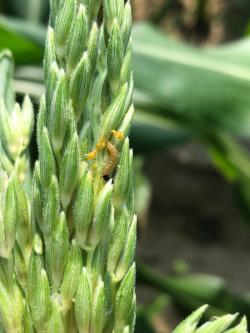
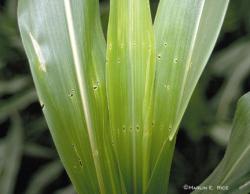 European corn borer: We saw our first ECB moths this week (NY strain), in a trap in Franklin Co. (see table 1). No feeding damage in the field yet at that site. All other trapping sites with traps up reported 0 moths this week. Moths emerge at 374 GDDs and lay eggs in corn foliage, preferring whorl-stage corn. Larvae emerge at 450 GDDs, and the earliest damage will be shot-holes in the foliage. Caterpillars will also feed in the tassels, causing them to lodge. As corn begins to silk, the caterpillars will move back down the stalk and re-enter near developing ears. Moths should be emerging soon in central and eastern MA, and we expect to see caterpillars beginning to feed this week in the CT River valley.
European corn borer: We saw our first ECB moths this week (NY strain), in a trap in Franklin Co. (see table 1). No feeding damage in the field yet at that site. All other trapping sites with traps up reported 0 moths this week. Moths emerge at 374 GDDs and lay eggs in corn foliage, preferring whorl-stage corn. Larvae emerge at 450 GDDs, and the earliest damage will be shot-holes in the foliage. Caterpillars will also feed in the tassels, causing them to lodge. As corn begins to silk, the caterpillars will move back down the stalk and re-enter near developing ears. Moths should be emerging soon in central and eastern MA, and we expect to see caterpillars beginning to feed this week in the CT River valley.
| Table 1. GDDs & Sweet corn pest trap captures for week ending May 29 | |||
|---|---|---|---|
| Trap/Weather Station Location | GDD* (base 50°F) |
ECB NY | ECB IA |
| Western MA | |||
| North Adams | 422 | n/a | n/a |
| Richmond | 333 | n/a | n/a |
| Westfield | 446 | - | - |
| Chicopee Falls | 443 | - | - |
| Whately | 433 | 15 | 0 |
| Central MA | |||
| Leominster | 348 | - | - |
| Northbridge | 361 | - | - |
| Worcester | 367 | - | - |
| Eastern MA | |||
| Bolton | 355 | - | - |
| Stow | 344 | - | - |
| Lawrence | 334 | - | - |
| Ipswich | 321 | - | - |
| East Bridgewater | 329 | - | - |
| Sharon | ND | 0 | 0 |
| Seekonk | 333 | 0 | 0 |
| Swansea | 0 | 0 | |
|
ND - no GDD data for this location - no numbers reported for this trap n/a this site does not trap for this pest *GDDs are reported from the nearest weather station to the trapping site |
|||
Contact Us
Contact the UMass Extension Vegetable Program with your farm-related questions, any time of the year. We always do our best to respond to all inquiries.
Vegetable Program: 413-577-3976, umassveg@umass.edu
Staff Directory: https://ag.umass.edu/vegetable/faculty-staff
Home Gardeners: Please contact the UMass GreenInfo Help Line with home gardening and homesteading questions, at greeninfo@umext.umass.edu.
Stemphylium Leaf Blight of Onion
Stemphylium leaf blight (SLB) of onion is caused by the fungus Stemphylium vesicarium. This disease has become increasingly problematic in onion growing regions of eastern North America over the past 15 years. We haven’t seen SLB in Massachusetts, although symptoms can look very similar to those of purple blotch or onion downy mildew, so it is possible that it is present but being misdiagnosed in the field. Downy mildew may be possible to definitively ID in the field but distinguishing between SLB and purple blotch requires a microscope.
Stemphylium produces small, elliptical, tan to brown or purplish lesions on onion foliage, sometimes with concentric rings. In severe cases, lesions may coalesce and defoliation may follow. Bulbs are not infected, but loss of photosynthetic capacity results in decreased bulb size and quality.
The fungus has a wide host range that includes ornamental plants. It has also been reported on alfalfa, asparagus, parsley, celery, pear, radish, soybean, and spinach. Recent research has shown that S. vesicarium may also infect several species of common weeds, sometimes without producing visible symptoms. Infected crop residue, volunteer onions, and weeds may be sources of inoculum in spring.
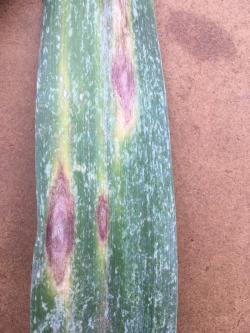
 Host specificity of S. vesicarium strains is not well understood. One study from Spain demonstrated that isolates from garlic, onion, and asparagus could cause disease in all three hosts. Another study showed that isolates from parsley were pathogenic to carrot, celery, and pear, but not to leek, onion, spinach, or tomato. Recently, an outbreak of leaf spot in celery caused by S. vesicarium was observed following rotation away from onion in Michigan. S. vesicarium does not cause gray leaf spot (GLS) of tomatoes—that disease is caused by Stemphylium solani and S. lycopersici. Although the pathogen may be seedborne, seed is not considered to be a significant source of inoculum in conventional onion production in North America; in addition to the widespread use of fungicide treated seed, most domestic onion seed is produced in arid areas of the continent where SLB is uncommon.
Host specificity of S. vesicarium strains is not well understood. One study from Spain demonstrated that isolates from garlic, onion, and asparagus could cause disease in all three hosts. Another study showed that isolates from parsley were pathogenic to carrot, celery, and pear, but not to leek, onion, spinach, or tomato. Recently, an outbreak of leaf spot in celery caused by S. vesicarium was observed following rotation away from onion in Michigan. S. vesicarium does not cause gray leaf spot (GLS) of tomatoes—that disease is caused by Stemphylium solani and S. lycopersici. Although the pathogen may be seedborne, seed is not considered to be a significant source of inoculum in conventional onion production in North America; in addition to the widespread use of fungicide treated seed, most domestic onion seed is produced in arid areas of the continent where SLB is uncommon.
A successful management program for SLB includes controlling weeds in and around onion fields. Control insect pests, especially onion thrips, which may increase disease incidence and severity. Rotate with non-host crops. No resistant onion cultivars are currently available. Disease forecasting models established for other similar foliar diseases have so far not been able to reliably predict S. vesicarium infection periods.
Several fungicides are labeled for use against Stemphylium leaf blight on onions. For a full listing, see the onion, scallion, and shallot disease control section of the New England Vegetable Management Guide. Research conducted in Ontario and New York onion fields found that a significant number of S. vesicarium isolates collected were insensitive to azoxystrobin (e.g. Quadris) , boscalid (e.g. Endura), cyprodinil (e.g. Switch, Inspire Super), and/or pyrimethanil (e.g. Scala, Luna Tranquility).
--Written by Angie Madieras, UMass Plant Diagnostic Lab
Colorado Potato Beetle Management
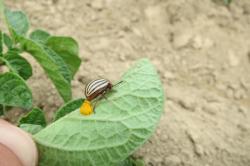 Colorado potato beetle (CPB) adults are likely just emerging from their overwintering sites and will soon begin to lay eggs on the undersides of leaves. This pest can quickly skeletonize potato and eggplant leaves and does significant damage to these crops every season. It is critical to control CPB when larvae are small, as larval damage is more severe than that of adults, with larger larvae causing 85% of the feeding damage. Adults are also much more tolerant to pesticides due to their hard outer wing case and the fact that they consume relatively little leaf material that may be treated with insecticide. Good control of CPB in June will not only protect vulnerable crops now, but will also reduce the number of beetles in the next generation that will overwinter to feed on next year’s crops.
Colorado potato beetle (CPB) adults are likely just emerging from their overwintering sites and will soon begin to lay eggs on the undersides of leaves. This pest can quickly skeletonize potato and eggplant leaves and does significant damage to these crops every season. It is critical to control CPB when larvae are small, as larval damage is more severe than that of adults, with larger larvae causing 85% of the feeding damage. Adults are also much more tolerant to pesticides due to their hard outer wing case and the fact that they consume relatively little leaf material that may be treated with insecticide. Good control of CPB in June will not only protect vulnerable crops now, but will also reduce the number of beetles in the next generation that will overwinter to feed on next year’s crops.
Life Cycle
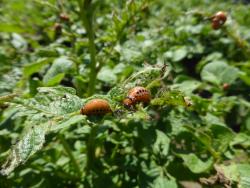
 In the Northeast, CPB feeds on solanaceous crops and weeds including potato, eggplant, tomato (primarily seedlings), horsenettle, and Eastern black nightshade. CPB overwinters in the adult stage, generally in soil (up to 12 inches deep) in the woods and brushy borders next to host crops, though some burrow into soil right in the field. In late spring, the beetles emerge to search for host plants. Adult CPB are fairly slow and clumsy; they can fly when temperatures are warm enough, but more often they walk into fields from overwintering sites. Heavy feeding may occur on edges of non-rotated fields. If beetles do not find host plants via walking, they will fly in search of food. Once they reach a host plant, adults feed, mate, and lay clusters of yellow-orange eggs on the undersides of leaves. One female can lay up to 300 eggs in her lifetime. Eggs hatch in 7 to 10 days, depending on temperature. The larvae are reddish-orange and grub-like with rows of black spots along the sides of their abdomen. They, along with the feeding damage they cause, are easily seen on leaves. Larvae go through four molts before they pupate—each stage of the larva is called an “instar”. In the first instar, the larvae are about the same size as the eggs and in the second instar they are about ⅛” long. Mature, fourth instar larvae are hump-backed and plump, and reach ⅝” before they drop to the soil and pupate. Adults emerge from pupae after 10 to 14 days, leaving round exit holes at the soil surface. In southern New England, there is a second generation of eggs, larvae, and adults in late July, while there is only one generation in northern New England. Beetles fly or walk out of fields in August, seeking overwintering sites at field edges.
In the Northeast, CPB feeds on solanaceous crops and weeds including potato, eggplant, tomato (primarily seedlings), horsenettle, and Eastern black nightshade. CPB overwinters in the adult stage, generally in soil (up to 12 inches deep) in the woods and brushy borders next to host crops, though some burrow into soil right in the field. In late spring, the beetles emerge to search for host plants. Adult CPB are fairly slow and clumsy; they can fly when temperatures are warm enough, but more often they walk into fields from overwintering sites. Heavy feeding may occur on edges of non-rotated fields. If beetles do not find host plants via walking, they will fly in search of food. Once they reach a host plant, adults feed, mate, and lay clusters of yellow-orange eggs on the undersides of leaves. One female can lay up to 300 eggs in her lifetime. Eggs hatch in 7 to 10 days, depending on temperature. The larvae are reddish-orange and grub-like with rows of black spots along the sides of their abdomen. They, along with the feeding damage they cause, are easily seen on leaves. Larvae go through four molts before they pupate—each stage of the larva is called an “instar”. In the first instar, the larvae are about the same size as the eggs and in the second instar they are about ⅛” long. Mature, fourth instar larvae are hump-backed and plump, and reach ⅝” before they drop to the soil and pupate. Adults emerge from pupae after 10 to 14 days, leaving round exit holes at the soil surface. In southern New England, there is a second generation of eggs, larvae, and adults in late July, while there is only one generation in northern New England. Beetles fly or walk out of fields in August, seeking overwintering sites at field edges.
Monitoring & Thresholds
The scouting procedure below was established for potato, but a similar process can be used in eggplant. Spray thresholds for both crops are listed in Table 1. There are no established thresholds for CPB in tomato, as it is not a preferred crop.
Scout weekly. Scout for beetles on 30 to 50 plants (or individual stalks when plants are taller than 18”). One recommended procedure is to walk the field in a V-shaped pattern and stop at 10 sites across the field. Randomize your selection of sites using a set number of paces (e.g. stop every 10 to 30 paces, depending on field size). At each location, select 3 to 5 plants or stalks, depending on the size of the plants. Alternatively, select plants or stalks individually at random across the field. Count adults, large larvae (greater than half-grown), and small larvae (less than half-grown) separately. A spray is warranted if any of the following thresholds are met:
| Potato | Eggplant | |
|---|---|---|
|
Thresholds per plant (<18" tall) or stalk (>18" tall) |
Plants <6" tall | Plants >6" Tall |
| 0.5 adults | 2 small larvae | 4 small larvae |
| 4 small larvae | ||
| 1.5 large larvae | 1 large larva | 2 large larvae |
| 10% defoliation | ||
If you are getting near the spray threshold, pay extra attention and scout again in 3-4 days. The New England Vegetable Management Guide recommends this tighter scouting schedule if numbers are above 15 adults, 75 small larvae, or 30 large larvae per 50 plants/stalks.
Use these scouting sheets to help keep track of the CPB populations: Potato, Eggplant, Tomato. These can be used for several different insects and diseases in each crop.
Controls & Prevention:
- Rotation. The single most important tactic for CPB management is to rotate potatoes, eggplants, and tomatoes to a field that is at least 200 yards from the previous year’s fields. Barriers such as roads, rivers, woodlands, and fields with other crops are helpful, because CPB adults are such slow and clumsy movers. This single practice delays and reduces colonization by adults, and therefore reduces the number of eggs and larvae in the field later.
- Crop health. Starting with healthy seed and maintaining good crop nutrition helps plants grow well and withstand feeding injury.
- Physical barriers such as straw mulch, trap crops, and trench traps may delay and reduce infestation.
- Straw mulch. It has been well documented that when potatoes or eggplants are mulched with straw, fewer CPB adults will settle on the plants and fewer eggs will be laid. This can be accomplished on larger plantings by planting into a rye cover crop, mowing down the rye, then pushing the rye straw over the plants after they emerge. For smaller plots, straw may be carried in.
- Perimeter trap cropping. Potato trap crops may be planted earlier than the main crop to attract beetles before the main crop emerges or planted between overwintering sites and this season’s crop. Flame, vacuum, or spray the border crop before beetles move into the main crop. Another approach is to plant 3 to 5 rows of potatoes treated with a systemic insecticide in a perimeter around the field; this treated border will kill up to 80% of the colonizing beetles. Planting main potato crops later than normal may also cause beetles to leave the field before potatoes emerge, resulting in lower beetle numbers.
- Trenches. This is a common recommendation, but we’ve never actually seen it in practice! The recommendation is to install plastic-lined trench traps next to overwintering sites at least 1 week before adults emerge, with trenches 1 - 2’ deep and 6 - 24” wide at the top. They can be U- or V-shaped with side walls sloping at angles between 65° and 90°. Beetles walking from field borders fall into the trench and cannot fly out. Let us know if you’ve ever tried it and if you’ve run into any pitfalls (maybe literally!).
- Flaming. Flame weeders can be used to kill colonizing adult beetles in potatoes when the crop is less than 5” tall. Move rapidly using a tractor-mounted or hand-held flamer. The goal is to scorch beetles, not burn them to death— injury to antennae and legs renders them unable to orient and climb plants, while burning them to death will result in excessive plant damage. At this early stage, healthy emerging potatoes have sufficient reserves to regrow foliage and establish well.
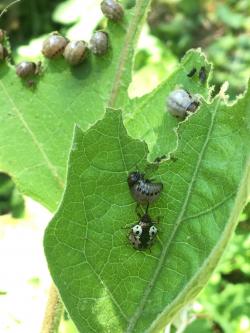 Biological control. Naturally occurring predators and parasites of CPB help suppress populations and prevent crop injury. Natural enemies that attack CPB eggs or larvae include twelve-spotted lady beetle (Coleomegilla maculata), spined soldier bug (Podisus maculiventris), a ground beetle (Lebia grandis), and a parasitic tachinid fly (Myiopharus doryphorae). The fungus Beauvaria bassiana (e.g. Mycotrol) has been shown to suppress beetle populations, though it does not provide immediate control. Using selective rather than broad-spectrum insecticides can help to conserve these natural enemies. Be aware that lady beetle egg masses look very similar to CPB egg masses, but lady beetle eggs are more yellow and slightly smaller (~1mm) than CPB eggs (~1.7 to 1.8mm), which are more orange.
Biological control. Naturally occurring predators and parasites of CPB help suppress populations and prevent crop injury. Natural enemies that attack CPB eggs or larvae include twelve-spotted lady beetle (Coleomegilla maculata), spined soldier bug (Podisus maculiventris), a ground beetle (Lebia grandis), and a parasitic tachinid fly (Myiopharus doryphorae). The fungus Beauvaria bassiana (e.g. Mycotrol) has been shown to suppress beetle populations, though it does not provide immediate control. Using selective rather than broad-spectrum insecticides can help to conserve these natural enemies. Be aware that lady beetle egg masses look very similar to CPB egg masses, but lady beetle eggs are more yellow and slightly smaller (~1mm) than CPB eggs (~1.7 to 1.8mm), which are more orange.- Hand removal. For smaller plantings and early infestations, walking through the crop to squish egg masses or drop adults into buckets of soapy water can be very effective to delay the build-up of damaging populations.
Chemical Control
Scout to determine if a damaging population is present. Labeled conventional products include pyrethroids, neonicotinoids, novaluron (e.g. Rimon), cyromazine (e.g. Trigard), and diamides (e.g. Verimark, Exirel). In recent years, we have observed resistance to both neonicotinoids (e.g. Assail, Belay, Venom, Actara, Cruiser, Platinum) and synthetic spinosads (e.g. Radiant) in New England. When using products that control only larvae or only small larvae, scout for eggs, note egg hatch, and apply controls before larvae reach third instar to avoid the worst feeding injury. For materials that control all stages, you may wait and scout for adults and larvae to determine the need to apply insecticides.
For organically managed fields, the selection of insecticides is limited to fewer active ingredients including spinosad (Entrust), azadirachtin (Azatin), pyrethrin (Pyganic), and Beauvaria bassiana (Mycotrol O, Botanigard), which can be tank-mixed and/or rotated. The Bt product Trident, which was developed a few years ago for CPB control, is still off the market due to formulation issues. With few products to choose from, it’s more important to time pesticide applications so that they are as effective as possible and therefore reduce the need for subsequent applications.
Ledprona is a new insecticide that was registered this year by the EPA for controlling CPB and is manufactured under the brand name Calantha. It is not yet registered in Massachusetts but is registered for use in the rest of New England. It is the first sprayable insecticide utilizing a novel mode of action based on RNA interference (RNAi) with the goal of providing effective and specific control of CPB. RNAi is a natural biological process which exists in most organisms and regulates the translation of messenger RNA, a step leading to the synthesis of proteins. Ingestion of certain manufactured double-stranded RNA (dsRNA) can activate this interference process in some organisms such as CPB, disrupting the expression of a vital enzyme in the insect’s metabolism and resulting in mortality within a few days of consumption. While the potential for dsRNA technology to cause non-target effects has been shown in other organisms, field studies of Ledprona have not found any significant negative effects on non-target arthropods. This, along with dsRNA’s rapid degradation in the environment, may allow for a decrease in environmental impacts stemming from CPB management. However, like with any other insecticide, resistance to RNAi-based biopesticides is likely to emerge if resistance management strategies are not used. Cautious use of this insecticide in combination with other IPM principles shows promise as a method of providing effective control of CPB while mitigating environmental risks.
Do not try to kill every beetle in the field. Potato crops can withstand 15% defoliation without affecting yields. Avoid treating potatoes for CPB late in the season, as defoliation less than two weeks before senescence will have little effect on final tuber bulking.
Resistance management must be part of every potato grower’s plan. CPB has a remarkable capacity to develop resistance to insecticides. Based on a fifty-year track record, we can expect that any insecticide that is used repeatedly on the same population of CPB (that is, those in the same field or farm) will lose its efficacy in less than five years. Where potato production is concentrated and rotation has been limited, resistance may develop on a region-wide basis. It’s up to you to manage resistance in the population of beetles on your farm, and keeping insecticides effective with careful rotations is a worthwhile investment. In the New England Vegetable Management Guide, as well as on pesticide labels, each insecticide has an IRAC (Insecticide Resistance Action Committee) Group Number, which identifies chemistries with the same mode of action. Growers should note the resistance group number of each insecticide, rotate classes of insecticides, and avoid using the same chemistry more than once per year, or even better, once every other year. Do not use the same chemical class on successive generations in the same year. Use newer chemistries first. For conventionally managed fields, there are enough different products to do a two-year rotation that will effectively control CPB while effectively delaying resistance to any one product.
See the potato and eggplant insect control sections of the New England Vegetable Management Guide for full lists of labeled materials.
--UMass Vegetable Program
Events
Twilight Meeting at Tangerini's Farm - Millis, MA
When: June 12, 2024, 4-7pm - free childcare available!
Where: Tangerini's Spring Street Farm,139 Spring Street, Millis, MA, 02054
Registration: Free! Please register in advance, for food ordering and childcare purposes. Click here to register.
Join Tangerini Farm, the UMass Extension Vegetable Program and SEMAP for a twilight meeting!
- Steve Chiarizio of Tangerini Farm will describe the new tile drainage system and bioreactor that they installed at the farm last year with the help of Massachusetts FSIG funding. A representative from Alleghany Services, who installed the system, will also be on hand to answer questions.
- Maria Gannett, UMass Extension Weed Specialist, and Sue Scheufele, UMass Extension Vegetable IPM Specialist, will talk about sweet corn weed and insect pest management options.
Presentations 4-6 pm, followed by a light supper.
Program co-sponsored by UMass Extension and the Southeastern Massachusetts Agricultural Partnership (SEMAP)
1 pesticide recertification credit is available for this program.
Field Walk at Brookfield Farm - Amherst, MA
When: Tuesday, June 25, 2024, 4-7pm
Where: Brookfield Farm, 24 Hulst Rd., Amherst, MA 01002
Registration: Free! Please register in advance, for food ordering purposes. Click here to register.
Join Brookfield Farm, the UMass Extension Vegetable Program and NOFA/Mass for a twilight meeting!
- Kerry and Max Taylor from Brookfield Farm will describe the new well they installed last year that includes a solar pump. The well was installed with support from NRCS.
- Sue Scheufele, UMass Extension Vegetable IPM Specialist, will lead a field walk and pest scouting demonstration.
- Maria Gannett, UMass Extension Weed Specialist, will lead a weed walk and discuss weed ID, organic weed management, and the relationship between weeds and soil health.
Presentations 4-6 pm, followed by a light supper.
1 pesticide recertification credit is available for this program.
This event is supported by the Transition to Organic Partnership Program.
Rice in the Northeast Farm School
When: Thursday & Friday, June 27-28, 2024
Where: Boundbook Farm, 276 Burroughs Farm Rd., Vergennes, VT 05491
Registration: $250, plus tent fees for camping. Click here to register.
The 2-day event is an intensive introduction to farming techniques specific to the northeastern United States. Tent camping at the farm is available, but limited to 25 tents. The Farm School registration fee is $250 and tent fees are additional. Registration is limited to 75 attendees.
- How to Farm Rice: Learn how to start a rice farm with rice varieties and technology adapted to the Northeastern U.S climate, growing conditions, and farming landscape. Learn about field preparation, duck-rice systems, drip-irrigation biomulching, crop varieties, harvesting, processing, and and marketing.
- Camping and Evening Event: On-site, tent camping is available on the farm for two nights. oy the delicious local foods and entertainment on the farm, including live music, a bonfire, and early morning birdwatching,
- Network with Future Rice Farmers: Farmers and agricultural extension educators across the Northeast are improving ways to farm rice ecologically. Now is the time to create a Northeastern rice cooperative. Be part of the founding NE farmers and educators to advance peer-to-peer learning.
Field Walk at Hannan Healthy Foods - Lincoln, MA
When: Wednesday, July 3, 2024, 4-6pm
Where: Hannan Healthy Foods, 270 South Great Rd., Lincoln, MA 01773. Park in the lot by the farm stand, carpool if possible as space is limited and the stand will be open to customers at this time.
Registration: Free! Please register in advance so we can order enough food. Click here to register.
Join Eastern MA CRAFT, UMass Extension, and NOFA/Mass for a pest walk at Hannan Healthy Foods in Lincoln, MA! We will discuss how to identify and monitor some of the most prolific and problematic pests and diseases ubiquitous to organic production. Scouting and identification are the first steps towards proactive mitigation practices, learn how to see the farm with fresh eyes.
2 pesticide recertification credits are available for this program.
This event is supported by the Transition to Organic Partnership Program.
Field Walk at Astarte Farm - Hadley, MA
When: Tuesday, July 9, 2024, 4-6pm followed by a light meal
Where: Astarte Farm, 123 West St., Hadley, MA 01035
Registration: Free! Please register in advance so we can order enough food. Click here to register.
Join Astarte Farm, the UMass Extension Vegetable Program and NOFA/Mass for a twilight meeting!
- Ellen and Dan from Astarte Farm will lead a tour of the farm, highlighting pollinator habitat that they've installed. The habitat was installed with funding from NRCS.
- Hannah Whitehead, UMass Extension Educator, will talk about the benefits of pollinator habitat for organic farmers.
- Sarah Burquest, UMass Lecturer and cut flower farmer, will discuss the flowers that she grows at Astarte.
1 pesticide recertification credit is available for this program.
This event is supported by and MDAR Specialty Crop Grant and the Transition to Organic Partnership Program.
Field Walk at Morning Glory Farm - Edgartown MA
When: Wednesday, July 17, 2024, 6-8pm
Where: Morning Glory Farm, Edgartown, MA
Registration: Free! Please register in advance so we can order enough food. Click here to register.
Join UMass Extension specialists Sue Scheufele and Maria Gannett for a field walk at Morning Glory Farm. We will identify current pest and weed issues in vegetable crops and discuss their management. There will be lots of time for Q&A, discussion, and dinner and refreshments will be provided.
2 pesticide recertification credits are available for this program.
This event is co-sponsored by NOFA/Mass and Martha’s Vineyard Ag Society with support from the Transition to Organic Partnership Program.
Water & Climate Change Twilight Meeting at Bardwell Farm – Hatfield, MA
When: Friday, August 2, 2024, 5-7pm, with dinner and discussion to follow
Where: Bardwell Farm, 49 Main St., Hatfield, MA 01038
Registration: Free! Please register in advance so we can order enough food. Click here to register.
Join UMass Extension and CISA for a climate-themed twilight meeting at Bardwell Farm in Hatfield, MA!
- Lisa McKeag will share findings from her recent water quality survey of farms around MA and discuss potential risks and impacts of weather and climate change and rising year-round temperatures on agricultural water quality.
- Harrison Bardwell will show off his new automated irrigation system, and discuss irrigation practices and funded projects around the farm.
- Sue Scheufele will discuss increasing pest risks caused by a hotter climate on vegetable pests including an on-farm trial for managing Phytophthora blight in peppers hosted by Bardwell Farm.
1 pesticide recertification credit is available for this program.
This event is co-sponsored by CISA as part of their Adapting your Farm to Climate Change Series.
Save the Date! UMass Research Farm Field Day
When: August 13, 2024, time TBD
Where: UMass Crop & Livestock Research & Education Farm, 89 River Rd., South Deerfield, MA
Registration: Coming soon!
Come learn about all the research being done by students and faculty across CNS and by UMass Extension on a tour of the farm. Topics include pollinator habitat, bee health and disease ecology, novel cover cropping strategies, intercropping to reduce greenhouse gas emissions, genetic basis of flowering traits in agriculture, and vegetable variety trials including heat-resistant lettuce varieties for summer production.
Twilight Meeting: Climate Impacts on Weed Management and Soil Health
When: Tuesday, October 8, 2024, 4-6pm, with a light supper to follow
Where: UMass Crop & Livestock Research & Education Farm, 89 River Rd., South Deerfield, MA, 01373
Registration: Free! Please register in advance so we can order enough food. Click here to register.
How are climate change and hotter temperatures affecting our soils? Often, practices like reducing tillage and cover cropping are recommended to improve soil health, reduce risk of topsoil loss and enhance resilience to drought and flood—practices that can also affect weed management. UMass Extension will discuss general impacts of climate change on soil health and highlight current research on updating recommendations for planting timing and overwintering survival of cover crop species in MA. Maria Gannett, UMass Extension Weeds Specialist, will relate these strategies to how they can impact weed management.
1 pesticide recertification credit is available for this program.
This event is co-sponsored by CISA as part of their Adapting your Farm to Climate Change Series.
Vegetable Notes. Maria Gannett, Genevieve Higgins, Lisa McKeag, Susan Scheufele, Alireza Shokoohi, Hannah Whitehead, co-editors. All photos in this publication are credited to the UMass Extension Vegetable Program unless otherwise noted.
Where trade names or commercial products are used, no company or product endorsement is implied or intended. Always read the label before using any pesticide. The label is the legal document for product use. Disregard any information in this newsletter if it is in conflict with the label.
The University of Massachusetts Extension is an equal opportunity provider and employer, United States Department of Agriculture cooperating. Contact your local Extension office for information on disability accommodations. Contact the State Center Directors Office if you have concerns related to discrimination, 413-545-4800.
